Coco-de-Mer, Double Coconut, Sea Coconut palm
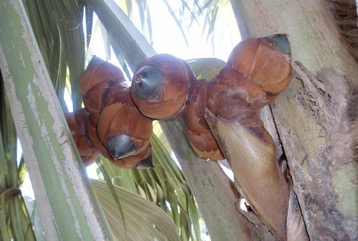
A subtropical plant. It suits the hot wet, lowland tropics. A warm or tropical climate is essential. A deep soil is important. It occurs naturally in the Seychelles. It suits hardiness zones 10-11.
Also known as:
Akraritennu, Darya-ka-naryal, Daryanunariyal, Jahari-naral, Kadalthengai, Kataltenna, On-hnition-poo, Palem biji kembar, Palem laut kembar, Samudrapu tenkaya, Ubie-narikaylum
Synonyms
- Borassus sonneratii Giseke
- Cocos maldivica J. F. Gmel.
- Cocos maritima Comm. ex H. Wendl.
- Lodoicea callipyge Commerson
- Lodoicea seychellarum Labill
- Lodoicea sonneratii (Giseke) Baill.
Edible Portion
- Nuts, Cabbage, Palm heart
Where does Coco-de-Mer grow?
Found in: Africa, Asia, Australia, China, Guyana, Hawaii, India, Indochina, Indonesia, Maldives, Myanmar, North Africa, Pacific, Philippines, SE Asia, Seychelles, Singapore, South America, Sri Lanka, Thailand
Notes: There is only one Lodoicea species.
Status: It is available dried in Chinese stores in Australia.
Growing Coco-de-Mer, Double Coconut, Sea Coconut palm
Cultivation: Plants are grown from seed. Seed may take 6-18 months. Seed need to be sown in their permanent position because they have a long sinker which may go 4 m deep. To overcome this problem in nurseries people stack several bottomless pots on top of each other.
Edible Uses: The unripe kernel and the crown of the trunk are eaten. They are also preserved in vinegar. The young immature nuts are eaten. The juice from the fruit pulp is eaten with sugar and cassa meal. The pulp yields an edible oil.
Production: They are slow growing. Plants can grow 30-60 years before flowering. Fruit take 5-7 years to mature on the plant. The time can also be half this. A fruit can weigh 20 kg.
Nutrition Info
per 100g edible portion| Edible Part | Energy (kcal) | Protein (g) | Iron (mg) | Vitamin A (ug) | Vitamin c (mg) | Zinc (mg) | % Water |
|---|---|---|---|---|---|---|---|
| - | - | - | - | - | - |
Coco-de-Mer, Double Coconut, Sea Coconut palm Photos

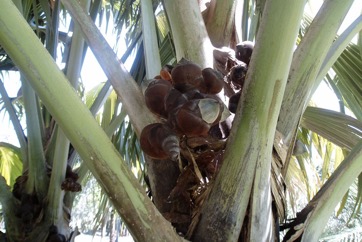
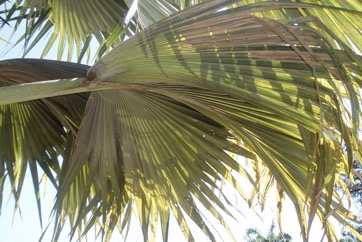
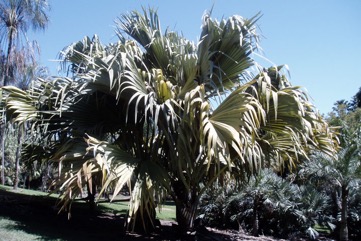
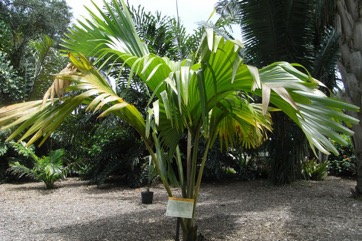
References
Balick, M.J. and Beck, H.T., (Ed.), 1990, Useful palms of the World. A Synoptic Bibliography. Colombia p 85, 121 (As Lodoicea callipyge), 412 (As Lodoicea seychellarum),
Brickell, C. (Ed.), 1999, The Royal Horticultural Society A-Z Encyclopedia of Garden Plants. Convent Garden Books. p 629
Burkill, I.H., 1966, A Dictionary of the Economic Products of the Malay Peninsula. Ministry of Agriculture and Cooperatives, Kuala Lumpur, Malaysia. Vol 2 (I-Z) p 1385
Coronel, R.E., 1982, Fruit Collections in the Philippines. IBPGR Newsletter p 10
Facciola, S., 1998, Cornucopia 2: a Source Book of Edible Plants. Kampong Publications, p 29
Gibbons, M., 2003, A pocket guide to Palms. Chartwell Books. p 142
Hedrick, U.P., 1919, (Ed.), Sturtevant's edible plants of the world. p 385 (As Lodoicea callipyge)
Hu, Shiu-ying, 2005, Food Plants of China. The Chinese University Press. p 302
Jardin, C., 1970, List of Foods Used In Africa, FAO Nutrition Information Document Series No 2.p 87 (As Lodoicea callipyge)
Jones, D.L., 1994, Palms throughout the World. Smithtonian Institution, Washington. p 57, 264
Jones, D.L., 2000, Palms of Australia 3rd edition. Reed/New Holland. p 180
Llamas, K.A., 2003, Tropical Flowering Plants. Timber Press. p 109
Marinelli, J. (Ed), 2004, Plant. DK. p 374
Martin, F. W., et al, 1987, Perennial Edible Fruits of the Tropics. USDA Handbook 642 p 47
Morley, B. & Everard, B., 1970, Wild Flowers of the World. Ebury press. Plate 191
Purseglove, J.W., 1972, Tropical Crops. Monocotyledons. Longmans p 426
Riffle, R.L. & Craft, P., 2003, An Encyclopedia of Cultivated Palms. Timber Press. p 381
Sukarya, D. G., (Ed.) 2013, 3,500 Plant Species of the Botanic Gardens of Indonesia. LIPI p 795
Swaminathan, M.S., and Kochnar, S.L., 2007, An Atlas of major Flowering Trees in India. Macmillan. p 280
Syn. pl. 2(2):630. 1807 (ex H. Wendl. in O. C. E. M. G. de Kerchove de Denterghem, Palmiers 250. 1878)
Wickens, G.E., 1995, Edible Nuts. FAO Non-wood forest products. FAO, Rome. p167
Wong, M., 2006, Edible Plants for Hawai'i Landscapes. College of Tropical Agriculture and Human Resources. Univ. of Hawai'i
World Checklist of Useful Plant Species 2020. Royal Botanic Gardens, Kew